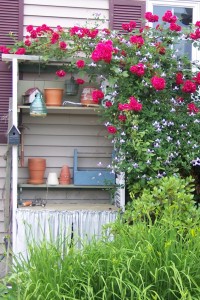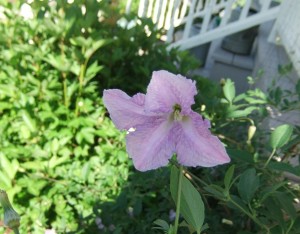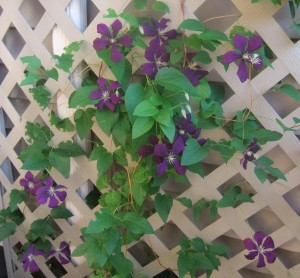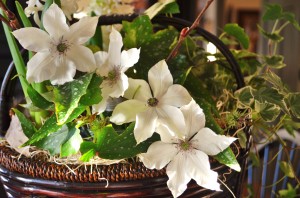Here at the Burrow, Clematis reigns as Queen of the Climbers. This versatile plant offers so many cultivars that I can have one in bloom (sometimes many) from May right through to October. Some of the newer hybrids will bloom for the entire summer, only stopped by a hard frost. That is truly impressive.
I think that every gardener should try to work at least a few of these vines into their planting scheme,once hooked by their beauty and versatility that number will go from one to many in a heartbeat!
If you have never grown a clematis, a good idea is to start with a cultivar of the vitacella species. These vines boast countless small flowers in interesting forms, are easy to grow and very resistant to clematis wilt, the fungal disease that will affect many of the larger blooming varieties.
clematis vitacella ‘Betty Corning’ is one of my longest blooming vines , and grows 12-15 ft and keeps it’s foliage well ( no brown or bare legs here!)
 The flower is a nodding lilac bell , very delicate on it’s own, and stunning when massed on a vine in full bloom. I grow it here with a climbing rose up the side of my potting bench, as well as through netting attached to my porch, and through a large viburnum that blooms in the spring. As I said , very versatile. In the late winter or early spring this clematis gets cut down to about 8-12 inches, or right above the first or second pair of healthy leaf buds, and will very quickly start shooting out new growth and flowering. There are many c. vitacella cultivars to choose from so you can have lots of color and flower forms .c.vitacella ‘Etoille Violette’ is another favorite that here shows off the vitacells tolerance for shade. It is planted on the northwest side of my house and shaded by a holly, yet manages to thrive and bloom (even though the slugs there can be nasty)
The flower is a nodding lilac bell , very delicate on it’s own, and stunning when massed on a vine in full bloom. I grow it here with a climbing rose up the side of my potting bench, as well as through netting attached to my porch, and through a large viburnum that blooms in the spring. As I said , very versatile. In the late winter or early spring this clematis gets cut down to about 8-12 inches, or right above the first or second pair of healthy leaf buds, and will very quickly start shooting out new growth and flowering. There are many c. vitacella cultivars to choose from so you can have lots of color and flower forms .c.vitacella ‘Etoille Violette’ is another favorite that here shows off the vitacells tolerance for shade. It is planted on the northwest side of my house and shaded by a holly, yet manages to thrive and bloom (even though the slugs there can be nasty) . It’s blooms are a very dark purple and shaped more like the saucers of the large flowered hybrids. Saying that c. vitacellas are easy to grow may seem to imply that othe clematis cultivars are difficult, but nothing could be further from the truth. In a nutshell if planted deeply with the crown of the plant AT LEAST 2-3 inches below the soil line, watered regularly ( 1 inch of rain a week or supplement when dry), and pruned according to how the individual plant blooms (more on that later) the are carefree easy perennial vines.
. It’s blooms are a very dark purple and shaped more like the saucers of the large flowered hybrids. Saying that c. vitacellas are easy to grow may seem to imply that othe clematis cultivars are difficult, but nothing could be further from the truth. In a nutshell if planted deeply with the crown of the plant AT LEAST 2-3 inches below the soil line, watered regularly ( 1 inch of rain a week or supplement when dry), and pruned according to how the individual plant blooms (more on that later) the are carefree easy perennial vines.
If you have a plant that gets afflicted with wilt you will know beacause one minute it looks droopy and thirsty (hence the name”wilt”) and literally within hours the vine shrivels and dies back. But IF planted deeply, the roots will be F I N E fine, and a new set of shoots will appear so don’t despair.
Here is the cliff notes version of pruning…hey it was all you used in school and you turned out just fine didn’t you?
There are 3 small blooming species that are readily available and grown in N.E. that bloom in early spring (late April-May).. They are c.montana, c.macropetala, and c.alpina. All of them have nice full foliage, sometimes it is a purply bronze when new , and colorful in the fall as well. These vines are well suited to covering eyesores like your neighbors ugly fence or a garage wall, they are large and are left as such. You only prune them if there is dead or diseased foliage, or if they grow wayward or out of hand.
The small flowered species and cultivars that bloom late (from June onward) ALL get cut back hard to 8-12 inches in the late winter or early spring, they bloom on new growth.
The large flowering hybrids, the ones that are listed as clematis’cultivar name’ eg clematis’Nelly Moser’ will be either hard pruned or lightly pruned if they bloom on new AND old wood (a lot of lightly pruned vines are doubles).the label will tell you which you have.
I can tell the early blooming vines easily so I don’t even have to think about them
and since all the other small bloomers get cut back hard, I just mark the light pruners with a piece of yarn tied on the vine or the structure it climbs on, so marked clematis get cut back about halfway after the first flush of blooms and everyone else gets cut back hard. Easy.
A word to the wise, I have heard other people lecture who said they cut back their clematis in the fall when they do a fall clean up. here is your word….DON’T. If we have a warm spell and the vine shoots out new growth, the subsequent freeze will kill the entire vine. Roots included. Patience my friend, wait until late Feb early March. Sit by the fire, read a book, pick pumpkins, whatever, but don’t prune the clematis.
Click on the following links to see more photos , get more cultivation tips, and see new hybrids growing here.

Hello. Do you have any experience with non-climbers, e.g. C. ‘China Purple’ or C. integrifolia?
I do , I grow many that are non-climbing including several integrifolia and heracleifolia cltvrs . They are really no-fuss plants that thrive here and the later brings so much color to the late season garden!